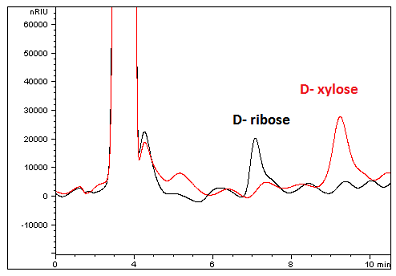When our team created the method for our application note of D-ribose and D-xylose, we had achieved a good level of separation which was a key feature for this particular set of analytes.
We recently revisited this work to see if any additional improvements could be made.
By increasing the length of the column dimension by 50 mm and reducing the flow rate by 0.5 mL/min, we were able to show a significant separation of these very similar polar sugars to distinguish the unique characteristics of our Cogent Amide™ column.

It is important to note, Refractive Index instruments are very sensitive to temperature and mobile phase fluctuations. It is very important to be aware of these factors as well as maintaining a proper calibrated machine, as goes with any instrument.
Since RI detectors are more particular to these changes, it is prudent to allow time to accommodate the instrument to acclimate the flow cell and sample cell for proper diode balancing.
Also, one may acquire better sensitivity by using a detector such as like MS, which does not suffer from some of the other issues that RI may encounter.

